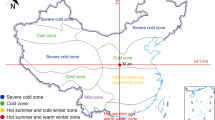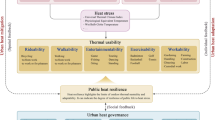Abstract
This article investigates the potential impact of thermal comfort on university teachers’ and students’ outdoor exercise via a case study of the thermal comfort of outdoor sports at the two campuses of Xi’an Jiaotong University—Xingqing Campus and Innovation Harbour Campus. Thermal comfort analysis is a crucial topic of urban environmental studies, but it has not yet been integrated with research on the improvement of outdoor sports spaces. This article is an attempt to fill this gap, using meteorological data gathered from a weather station and questionnaires gathered from the respondents. With collected data, the present research then uses linear regression to probe into the relationship between Mean Thermal Sensation Vote (MTSV), Mean Thermal Comfort Vote (MTCV), and MPET, to demonstrate general trends and display the PET values when TSV is most ideal. The results show that the significant differences in thermal comfort between the two campuses exert little impact on people’s will to exercise. Under the ideal thermal sensation, the calculated PET values for the Xingqing Campus and Innovation Harbour Campus were 25.55°C and 26.61°C respectively. The article ends with concrete suggestions on practical strategies to improve the thermal comfort of outdoor sports spaces.




















Similar content being viewed by others
References
Abdallah ASH (2022) Passive design strategies to improve student thermal comfort in Assiut University: a field study in the Faculty of Physical Education in hot season. Sustain Cities Soc 86:104110
Acero JA, Ruefenacht LA, Koh EJ, Tan YS, Norford LK (2022) Measuring and comparing thermal comfort in outdoor and semi-outdoor spaces in tropical Singapore. Urban Clim 42:101122
Bouyer J, Vinet J, Delpech P, Carré S (2007) Thermal comfort assessment in semi-outdoor environments: application to comfort study in stadia. J Wind Eng Ind Aerodyn 95(9-11):963–976
de Dear R, Spagnolo J (2005) Thermal comfort in outdoor and semi-outdoor environments. In Elsevier Ergonomics Book Series (Vol. 3, pp. 269-276). Elsevier
Deevi B, Chundeli FA (2020) Quantitative outdoor thermal comfort assessment of street: a case in a warm and humid climate of India. Urban Clim 34:100718
Deng X, Nie W, Li X, Wu J, Yin Z, Han J et al (2023) Influence of built environment on outdoor thermal comfort: a comparative study of new and old urban blocks in Guangzhou. Build Environ 110133
Gómez F, Cueva AP, Valcuende M, Matzarakis A (2013) Research on ecological design to enhance comfort in open spaces of a city (Valencia, Spain). Utility of the physiological equivalent temperature (PET). Ecol Eng 57:27–39
Gulyás Á, Unger J, Matzarakis A (2006) Assessment of the microclimatic and human comfort conditions in a complex urban environment: modelling and measurements. Build Environ 41(12):1713–1722
Henriques IB, Mady CEK, de Oliveira Junior S (2017) Assessment of thermal comfort conditions during physical exercise by means of exergy analysis. Energy 128:609–617
Höppe P (1999) The physiological equivalent temperature–a universal index for the biometeorological assessment of the thermal environment. Int J Biometeorol 43:71–75
Huan C, Wang F, Li S, Zhao Y, Liu L, Wang Z, Ji C (2019) A performance comparison of serial and parallel solar-assisted heat pump heating systems in Xi’an China. Energy Sci Eng 7(4):1379–1393
Huang Z, Cheng B, Gou Z, Zhang F (2019) Outdoor thermal comfort and adaptive behaviors in a university campus in China’s hot summer-cold winter climate region. Build Environ 165:106414
Ishmatov A (2020) Influence of weather and seasonal variations in temperature and humidity on supersaturation and enhanced deposition of submicron aerosols in the human respiratory tract. Atmos Environ 223:117226
Ji Y, Song J, Shen P (2022) A review of studies and modelling of solar radiation on human thermal comfort in outdoor environment. Build Environ, 108891
Khalili S, Fayaz R, Zolfaghari SA (2022) Analyzing outdoor thermal comfort conditions in a university campus in hot-arid climate: a case study in Birjand. Iran Urban Climate 43:101128
Kong D, Liu H, Wu Y, Li B, Wei S, Yuan M (2019) Effects of indoor humidity on building occupants’ thermal comfort and evidence in terms of climate adaptation. Build Environ 155:298–307
Kumar P, Sharma A (2022) Assessing outdoor thermal comfort conditions at an urban park during summer in the hot semi-arid region of India. Materials Today: Proceedings 61:356–369
Lam CKC, Cui S, Liu J, Kong X, Ou C, Hang J (2021) Influence of acclimatization and short-term thermal history on outdoor thermal comfort in subtropical South China. Energy and Buildings 231:110541
Lau KKL, Choi CY (2021) The influence of perceived aesthetic and acoustic quality on outdoor thermal comfort in urban environment. Build Environ 206:108333
Li K, Zhang Y, Zhao L (2016) Outdoor thermal comfort and activities in the urban residential community in a humid subtropical area of China. Energy and Buildings 133:498–511
Li Y, Hong B, Wang Y, Bai H, Chen H (2022b) Assessing heat stress relief measures to enhance outdoor thermal comfort: a field study in China’s cold region. Sustain Cities Soc 80:103813
Li Z, Feng X, Fan X, Sun J, Fang Z (2022a) Effect of direct solar projected area factor on outdoor thermal comfort evaluation: a case study in Shanghai China. Urban Climate 41:101033
Liu K, Lian Z, Dai X, Lai D (2022) Comparing the effects of sun and wind on outdoor thermal comfort: a case study based on longitudinal subject tests in cold climate region. Sci Total Environ 825:154009
Manavvi S, Rajasekar E (2022) Evaluating outdoor thermal comfort in urban open spaces in a humid subtropical climate: Chandigarh India. Building and Environ 209:108659
Matzarakis A, Endler C (2010) Climate change and thermal bioclimate in cities: impacts and options for adaptation in Freiburg Germany. Intl J Biometeorol 54(4):479–483
Matzarakis A, Mayer H, Iziomon MG (1999) Applications of a universal thermal index: physiological equivalent temperature. Int J Biometeorol 43(2):76–84
Matzarakis A, Rutz F, Mayer H (2007) Modelling radiation fluxes in simple and complex environments—application of the RayMan model. Int J Biometeorol 51(4):323–334
Mayer H (1993) Urban bioclimatology. Experientia 49:957–963
Mohammadzadeh N, Karimi A, Brown RD (2023) The influence of outdoor thermal comfort on acoustic comfort of urban parks based on plant communities. Build Environ 228:109884
Nagano C, Tanaka R, Mori K, Fukuzawa K, Horie S (2022) Helmet-type measuring device for estimating the amount of sweating in a hot environment. Saf Health Work 13:S272
Nasrollahi N, Namazi Y, Taleghani M (2021) The effect of urban shading and canyon geometry on outdoor thermal comfort in hot climates: a case study of Ahvaz Iran. Sustain Cities Soc 65:102638
Nouri AS, Lopes A, Costa JP, Matzarakis A (2018) Confronting potential future augmentations of the physiologically equivalent temperature through public space design: the case of Rossio, Lisbon. Sustain Cities Soc 37:7–25
Omonijo AG (2017) Assessing seasonal variations in urban thermal comfort and potential health risks using physiologically equivalent temperature: a case of Ibadan, Nigeria. Urban Clim 21:87–105
Qin H, Wang X (2022) A multi-discipline predictive intelligent control method for maintaining the thermal comfort on indoor environment. Appl Soft Comput 116:108299
Qingqing W, Jianhua L, Liang Z, Jiawen Z, Linlin J (2020) Effect of temperature and clothing thermal resistance on human sweat at low activity levels. Build Environ 183:107117
Sarhadi F, Rad VB (2020) The structural model for thermal comfort based on perceptions individuals in open urban spaces. Build Environ 185:107260
Shah R, Pandit RK, Gaur MK (2022) Urban physics and outdoor thermal comfort for sustainable street canyons using ANN models for composite climate. Alexandria Eng J 61(12):10871–10896
Song B, Bai L, Yang L (2022) Analysis of the long-term effects of solar radiation on the indoor thermal comfort in office buildings. Energy 247:123499
Speak A, Montagnani L, Wellstein C, Zerbe S (2021) Forehead temperatures as an indicator of outdoor thermal comfort and the influence of tree shade. Urban Clim 39:100965
Su M, Hong B, Su X, Liu A, Chang J (2022) How the nozzle density and height of mist spraying affect pedestrian outdoor thermal comfort: A field study. Build Environ 215:108968
Tucker P, Gilliland J (2007) The effect of season and weather on physical activity: a systematic review. Public Health 121(12):909–922
Vellei M, Herrera M, Fosas D, Natarajan S (2017) The influence of relative humidity on adaptive thermal comfort. Build Environ 124:171–185
Wei D, Yang L, Bao Z, Lu Y, Yang H (2022) Variations in outdoor thermal comfort in an urban park in the hot-summer and cold-winter region of China. Sustain Cities Soc 77:103535
Woldehiwet Z, Mamache B, Rowan TG (1990) The effects of age, environmental temperature and relative humidity on the bacterial flora of the upper respiratory tract in calves. Br Vet J 146(3):211–218
Xi T, Li Q, Mochida A, Meng Q (2012) Study on the outdoor thermal environment and thermal comfort around campus clusters in subtropical urban areas. Build Environ 52:162–170
Xu M, Hong B, Mi J, Yan S (2018) Outdoor thermal comfort in an urban park during winter in cold regions of China. Sustain Cities Soc 43:208–220
Yao F, Fang H, Han J, Zhang Y (2022) Study on the outdoor thermal comfort evaluation of the elderly in the Tibetan plateau. Sustain Cities Soc 77:103582
Zhang L, Wei D, Hou Y, Du J, Liu ZA, Zhang G, Shi L (2020) Outdoor thermal comfort of urban park—a case study. Sustainability 12(5):1961
Zhao L, Zhou X, Li L, He S, Chen R (2016) Study on outdoor thermal comfort on a campus in a subtropical urban area in summer. Sustain Cities Soc 22:164–170
Acknowledgements
The authors of this paper sincerely appreciate Sifang Yang, Jiangying Liu, Wanting Zhao, Qianqian Deng, Jinhua Li, Fangjun Liu, and Xinxin Long for their effort in data collecting. We also want to express our heartfelt thanks to Heather Ho and Jiawei Li for their consistent and countless help.
Funding
This work was supported by the Key Scientific Research Projects of Colleges and Universities in Henan Province (Grant No. 22B560020), the National Key R&D Program of China (2020YFB1708900), the China National Natural Science Foundation (61872224), and Shandong Provincial Natural Science Foundation of China (ZR2017MF003).
Author information
Authors and Affiliations
Contributions
Chenlin Wei and Liyao Zhao conceived and completed this paper. Han Chang supervised the implementation of the research. Chenlin Wei, Liyao Zhao, and Han Chang proposed the concept of the research. Pengfei Xumo supported the writing.
Corresponding author
Ethics declarations
Ethical approval
No human or animal study was conducted during the present research.
Consent to participate
Not applicable.
Consent for publication
Not applicable.
Competing interests
The authors declare no competing interests.
Additional information
Responsible Editor: Philippe Garrigues
Publisher’s note
Springer Nature remains neutral with regard to jurisdictional claims in published maps and institutional affiliations.
Rights and permissions
Springer Nature or its licensor (e.g. a society or other partner) holds exclusive rights to this article under a publishing agreement with the author(s) or other rightsholder(s); author self-archiving of the accepted manuscript version of this article is solely governed by the terms of such publishing agreement and applicable law.
About this article
Cite this article
Wei, C., Zhao, L., Chang, H. et al. Thermal comfort analysis and improvement of outdoor sports spaces in universities: a case study of Xi’an Jiaotong University. Environ Sci Pollut Res 30, 76575–76594 (2023). https://doi.org/10.1007/s11356-023-27881-7
Received:
Accepted:
Published:
Issue Date:
DOI: https://doi.org/10.1007/s11356-023-27881-7




